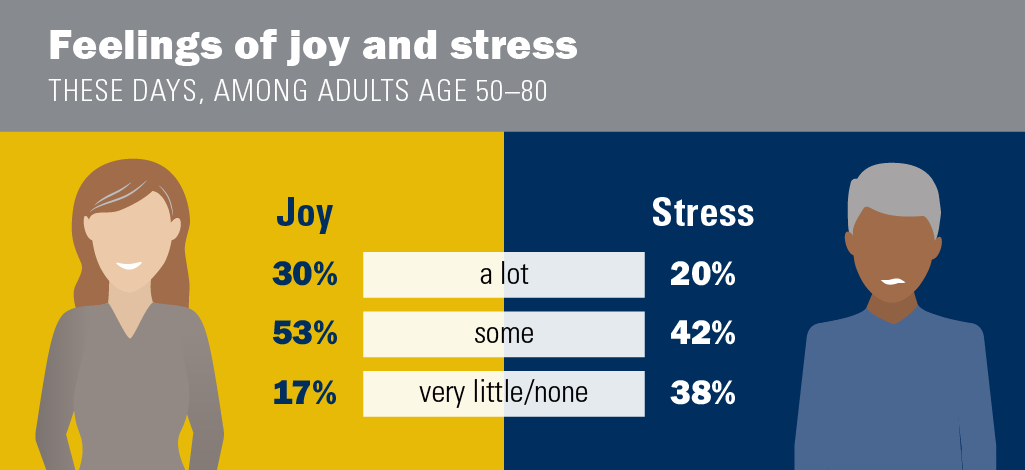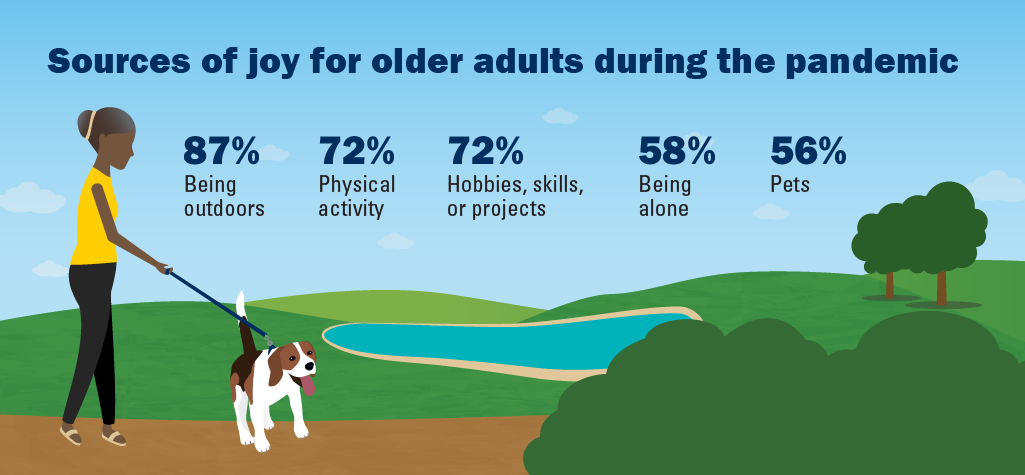
The COVID-19 pandemic has had complex effects on the emotional and mental health of older adults. To better understand its impact, in August 2021 the University of Michigan National Poll on Healthy Aging asked a national sample of adults age 50–80 about joys, stresses and resilience during the pandemic, and their outlook on the future.
Current levels of joy and stress
Most adults age 50–80 reported feeling a lot (30%) or some (53%) joy these days, while 17% reported feeling very little or no joy. Meanwhile, 20% of older adults reported feeling a lot of stress these days and 42% felt some stress, whereas 38% felt very little or no stress. Adults age 50–64 were more likely to report feeling a lot of stress compared to those age 65–80 (25% vs 13%), as were women compared to men (24% vs 15%). About half of older adults (47%) said they felt both joy and stress (a lot or some for both).
Older adults in excellent or very good physical health were much more likely to report feeling a lot of joy compared to those in fair or poor physical health (44% vs 16%), and less likely to report feeling a lot of stress (12% vs 37%). Similarly, those with excellent or very good mental health were much more likely to report feeling a lot of joy compared to those in fair or poor mental health (43% vs 4%) and less likely to report feeling a lot of stress (8% vs 62%). Those in the lowest income households (<$30,000) were more likely than those in the highest income households (>$100,000) to have experienced a lot of stress (26% vs 18%) and less likely to report feeling a lot of joy (21% vs 33%).

Sources of joy and stress
Since March 2020, sources of joy for older adults included being outdoors (87%); physical activity (72%); spending time on hobbies, skills, or projects (72%); being alone (58%); pets (56%); volunteering or helping others (43%); attending spiritual or religious activities (39%); work (35%); and attending online events (22%).
Four in five older adults also found joy in connecting with others in person (83%) and by phone or virtually (79%). Three in five adults age 50–80 (60%) found joy in new or strengthened relationships and 37% in spending time on social media.
Most older adults reported that their relationships with their children (70%) and spouse/partner (64%) have brought them some or a lot of joy since March 2020. Relationships with friends (80%), co-workers (61%), grandchildren (51%), and neighbors (48%) were also sources of joy during this period.
Older adults indicated that relationships could also be a source of some or a lot of stress, including relationships with their spouse/partner (30%) or with their children (29%).
Experiences of stress and loss
About two in three older adults reported that the well-being of family or friends (67%) and national events or politics (66%) caused them a lot or some stress since March 2020. During this period 47% felt stress about their health in general and 45% felt stress about money.
Many adults reported feeling a sense of loss over missing activities or experiences during the pandemic, or not being able to do them in the way they typically would. This included about two in three older adults who reported feeling a lot or some loss over not being able to see family (66%) or friends (63%) in person. Missing experiences such as going on vacation (59%), attending celebrations such as birthday parties or weddings (54%), and attending large events such as concerts or festivals (42%) also brought feelings of loss.
COVID-19-related stress
As of August 2021, 48% of older adults experienced some or a lot of stress about getting COVID-19. When rating their feelings of stress stemming from thinking about or engaging in activities that could raise the risk of exposure to COVID-19, 58% of adults age 50–80 felt a lot or some stress about being in a crowded indoor space, 41% about being in a crowded outdoor space, 34% about having visitors in their home, and 27% about simply leaving their home.

Resilience and the future
The majority of adults age 50–80 (71%) reported feeling the same level of resilience (i.e., being able to overcome challenges, recover, and “bounce back”) as they did before the COVID-19 pandemic, with 15% feeling more resilient. Meanwhile, 14% of older adults reported feeling less resilient than before the pandemic; those with worse physical and mental health were the most likely to feel this way. Those in fair or poor physical health or mental health were more likely than those in excellent or very good physical or mental health to report feeling less resilient than before the pandemic (25% vs 9% for physical health and 43% vs 6% for mental health).
When thinking about the future, 20% of older adults reported feeling a lot of stress and 48% reported feeling some stress. In addition, when thinking about the future, 28% of older adults reported feeling a lot of joy and 51% reported feeling some joy. Those in fair or poor physical or mental health were more likely to feel a lot of stress and very little or no joy when thinking about the future than those in excellent or very good physical or mental health.
Implications
In this poll, over four in five US adults age 50–80 reported feeling joy (some or a lot) in their lives these days. Stress was often simultaneously experienced alongside joy, with about half of adults saying they felt a lot or some of both. Those experiencing less joy and greater stress were more likely to have fair or poor physical or mental health. There were notable income disparities in experiences of joy and stress, highlighting the potential vulnerability of older adults in lower income households to the current economic and social conditions.
Adults age 65–80 experienced more joy and less stress than those age 50–64. This finding is consistent with recent studies demonstrating that the oldest adults have been relatively buffered from the negative mental health effects of the COVID-19 pandemic. Research both prior to and during the pandemic indicates that resilience and wisdom increase with age, which may promote mental health and well-being.
Close social ties with spouse/partner, children, grandchildren, and friends were common sources of joy during the pandemic. Connecting with others was also a common source of joy. While the pandemic has altered relationships and disrupted some ways of communicating, continued engagement in social relationships is important for mental health during and beyond the pandemic.
This poll and previous studies highlight the emotional and mental health effects of altered daily life during the COVID-19 pandemic. A notable proportion of older adults reported feeling some or a lot of stress when thinking about typical situations, such as being in crowded spaces and leaving the house. Yet many older adults found joy in activities that can be done safely, such as physical activity and spending time outside or on hobbies, skills, or projects.
People in poorer physical or mental health were more likely to experience pandemic-related stress and less likely to experience joy both these days and in thinking about the future. As COVID-19 continues to spread, public health authorities should clearly communicate local levels of risk, and communities and health care providers should promote activities that older adults can most safely engage in so as to mitigate the adverse emotional and mental health effects of the pandemic on older adults, particularly those in poorer health.
Understanding the joys and stresses experienced by older adults during the COVID-19 pandemic can help policymakers, health care providers, and older adults themselves promote well-being and cultivate resilience during times of national and global crisis.
Data Source and Methods
This National Poll on Healthy Aging report presents findings from a nationally representative household survey conducted exclusively by NORC at the University of Chicago for the University of Michigan’s Institute for Healthcare Policy and Innovation. National Poll on Healthy Aging surveys are conducted using NORC’s AmeriSpeak probability-based panel. This survey module was administered online and via phone in August 2021 to a randomly selected, stratified group of U.S. adults age 50–80 (n=2,110). The sample was subsequently weighted to reflect population figures from the U.S. Census Bureau. The completion rate was 64% among panel members contacted to participate. The margin of error is ±1 to 3 percentage points for questions asked of the full sample and higher among subgroups.
Findings from the National Poll on Healthy Aging do not represent the opinions of the University of Michigan. The University of Michigan reserves all rights over this material.
Read other National Poll on Healthy Aging reports and about the poll's Michigan findings, and learn about the poll methodology.
Citation
Kobayashi L, Finlay J, Solway E, Singer D, Kirch M, Kullgren J, Smith E, Malani P. Joy and Stress During the COVID-19 Pandemic. University of Michigan National Poll on Healthy Aging. December 2021/January 2022. Available at: https://dx.doi.org/10.7302/3749